Long-Term Dynamics of Ecosystem Services and Their Influencing Factors in Ecologically Fragile Southwest China
Abstract
:1. Introduction
2. Materials and Methods
2.1. Study Area
2.2. Data Source and Processing
2.2.1. Precipitation Data
2.2.2. Soil Properties Data
2.2.3. Digital Elevation Model (DEM) Data
2.2.4. Land Use and Cover Data
2.2.5. Net Ecosystem Productivity (NEP) Data
2.2.6. Evapotranspiration Data
2.3. Methods
2.3.1. Water Conservation
2.3.2. Carbon Sequestration
2.3.3. Soil Conservation
2.3.4. Statistical Analysis
2.3.5. Partial Correlation Analysis
3. Results
3.1. Spatio-Temporal Variability of Ecosystem Service Functions
3.2. Long-Term Trend of Ecosystem Service Functions
3.3. Effect of Environmental Factors
4. Discussion
4.1. Impact of Precipitation on Ecosystem Services
4.2. Impact of Land Use Changes on Ecosystem Services
4.3. Management Implications
5. Conclusions
Author Contributions
Funding
Data Availability Statement
Conflicts of Interest
References
- Braat, L.C.; de Groot, R. The ecosystem services agenda: Bridging the worlds of natural science and economics, conservation and development, and public and private policy. Ecosyst. Serv. 2012, 1, 4–15. [Google Scholar] [CrossRef] [Green Version]
- Xie, G.; Zhang, C.; Zhen, L.; Zhang, L. Dynamic changes in the value of China’s ecosystem services. Ecosyst. Serv. 2017, 26, 146–154. [Google Scholar] [CrossRef]
- Costanza, R.; d’Arge, R.; de Groot, R.; Farber, S.; Grasso, M.; Hannon, B.; Limburg, K.; Naeem, S.; O’Neill, R.V.; Paruelo, J.; et al. The value of the world’s ecosystem services and natural capital. Nature 1997, 387, 253–260. [Google Scholar] [CrossRef]
- Zheng, D.; Wang, Y.; Hao, S.; Xu, W.; Lv, L.; Yu, S. Spatial-temporal variation and tradeoffs/synergies analysis on multiple ecosystem services: A case study in the Three-River Headwaters Region of China. Ecol. Indic. 2020, 116, 106494. [Google Scholar] [CrossRef]
- Bateman, I.J.; Harwood, A.R.; Mace, G.M.; Watson, R.T.; Abson, D.J.; Andrews, B.; Binner, A.; Crowe, A.; Day, B.H.; Dugdale, S.; et al. Bringing ecosystem services into economic decision-making: Land use in the United Kingdom. Science 2013, 341, 45–50. [Google Scholar] [CrossRef] [PubMed]
- Goldscheider, N.; Chen, Z.; Auler, A.S.; Bakalowicz, M.; Broda, S.; Drew, D.; Hartmann, J.; Jiang, G.; Moosdorf, N.; Stevanovic, Z.; et al. Global distribution of carbonate rocks and karst water resources. Hydrogeol. J. 2020, 28, 1661–1677. [Google Scholar] [CrossRef] [Green Version]
- Medici, G.; Lorenzi, V.; Sbarbati, C.; Manetta, M.; Petitta, M. Structural Classification, Discharge Statistics, and Recession Analysis from the Springs of the Gran Sasso (Italy) Carbonate Aquifer; Comparison with Selected Analogues Worldwide. Sustainability 2023, 15, 10125. [Google Scholar] [CrossRef]
- Sun, M.Y.; Yang, R.J.; Li, X.H.; Zhang, L.; Liu, Q. Designing a path for the sustainable development of key ecological function zones: A case study of southwest China. Glob. Ecol. Conserv. 2021, 31, e01840. [Google Scholar] [CrossRef]
- Su, X.; Shen, Y.; Xiao, Y.; Liu, Y.; Cheng, H.; Wan, L.; Zhou, S.; Yang, M.; Wang, Q.; Liu, G. Identifying Ecological Security Patterns Based on Ecosystem Services Is a Significative Practice for Sustainable Development in Southwest China. Front. Ecol. Evol. 2022, 9, 1020. [Google Scholar] [CrossRef]
- Banks, D.; Odling, N.E.; Skarphagen, H.; Rohr-Torp, E. Permeability and stress in crystalline rocks. Terra Nova 1996, 8, 223–235. [Google Scholar] [CrossRef]
- Manoutsoglou, E.; Lazos, I.; Steiakakis, E.; Vafeidis, A. The Geomorphological and Geological Structure of the Samaria Gorge, Crete, Greece—Geological Models Comprehensive Review and the Link with the Geomorphological Evolution. Appl. Sci. 2022, 12, 10670. [Google Scholar] [CrossRef]
- Stober, I.; Bucher, K. Origin of salinity of deep groundwater in crystalline rocks. Terra Nova 1999, 11, 181–185. [Google Scholar] [CrossRef]
- Qiu, S.; Peng, J.; Dong, J.; Wang, X.; Ding, Z.; Zhang, H.; Mao, Q.; Liu, H.; Quine, A.T.; Meersmans, J. Understanding the relationships between ecosystem services and associated social-ecological drivers in a karst region: A case study of Guizhou Province, China. Prog. Phys. Geogr. Earth Environ. 2021, 45, 98–114. [Google Scholar] [CrossRef]
- Tong, X.; Brandt, M.; Yue, Y.; Horion, S.; Wang, K.; Keersmaecker, W.D.; Tian, F.; Schurgers, G.; Xiao, X.; Luo, Y. Increased vegetation growth and carbon stock in China karst via ecological engineering. Nat. Sustain. 2018, 1, 44–50. [Google Scholar] [CrossRef]
- Wang, Q.; Xiong, K.; Zhou, J.; Xiao, H.; Song, S. Impact of land use and land cover change on the landscape pattern and service value of the village ecosystem in the karst desertification control. Front. Environ. Sci. 2023, 11, 1020331. [Google Scholar] [CrossRef]
- Han, H.; Su, Z. Research progress and prospects of karst ecosystem services. Carsologica Sin. 2017, 36, 352–358. (In Chinese) [Google Scholar]
- Hou, L.; Wu, F.; Xie, X. The spatial characteristics and relationships between landscape pattern and ecosystem service value along an urban-rural gradient in Xi’an City, China. Ecol. Indic. 2020, 108, 105720. [Google Scholar] [CrossRef]
- De Groot, R.S.; Fisher, B.; Christie, M.; Aronson, J.; Braat, L.; Haines-Young, R.; Gowdy, J.; Maltby, E.; Neuville, A.; Polasky, S. Integrating the ecological and economic dimensions in biodiversity and ecosystem service valuation. In The Economics of Ecosystems and Biodiversity Ecological and Economic Foundations; Kumar, P., Ed.; Earthscan: London, UK, 2010; pp. 9–40. [Google Scholar]
- Schmeller, D.S.; Niemelä, J.; Bridgewater, P. The Intergovernmental Science-Policy Platform on Biodiversity and Ecosystem Services (IPBES): Getting involved. Biodivers. Conserv. 2017, 26, 2271–2275. [Google Scholar] [CrossRef] [Green Version]
- Gao, J.; Xiong, K. Ecosystem service value responses to ecological control in Karst region-A case study of Huajiang Gorge Demonstration Area of rocky desertification control in Guizhou. Chin. J. Eco Agric. 2015, 23, 775–784. (In Chinese) [Google Scholar]
- Luo, G.; Wang, S.; Li, Y.; Bai, X. Spatio-temporal dynamics and ecological service function assessment of slope farmland in Karst areas of Guizhou province, China. Trans. Chin. Soc. Agric. Eng. 2014, 30, 233–243. (In Chinese) [Google Scholar]
- Başkent, E.Z. Assessment and valuation of key ecosystem services provided by two forest ecosystems in Turkey. J. Environ. Manag. 2021, 285, 112135. [Google Scholar] [CrossRef]
- Liu, G.; Shao, Q.; Fan, J.; Ning, J.; Huang, H.; Liu, S.; Zhang, X.; Niu, L.; Liu, J. Spatio-temporal changes, trade-offs and synergies of major ecosystem services in the Three-River Headwaters Region from 2000 to 2019. Remote Sens. 2022, 14, 5349. [Google Scholar] [CrossRef]
- Mendoza-Ponce, A.; Corona-Nunez, R.; Kraxner, F.; Leduc, S.; Patrizio, P. Identifying effects of land use cover changes and climate change on terrestrial ecosystems and carbon stocks in Mexico. Glob. Environ. Chang. 2018, 53, 12–23. [Google Scholar] [CrossRef] [Green Version]
- Peng, J.; Tian, L.; Zhang, Z.; Zhao, Y.; Green, S.M.; Quine, T.A.; Liu, H.; Meersmans, J. Distinguishing the impacts of land use and climate change on ecosystem services in a karst landscape in China. Ecosyst. Serv. 2020, 46, 101199. [Google Scholar] [CrossRef]
- Dai, X.; Wang, L.; Li, X.; Gong, J.; Cao, Q. Characteristics of the extreme precipitation and its impacts on ecosystem services in the Wuhan Urban Agglomeration. Sci. Total Environ. 2023, 864, 161045. [Google Scholar] [CrossRef]
- Guo, Q.; Yu, C.; Xu, Z.; Yang, Y.; Wang, X. Impacts of climate and land-use changes on water yields: Similarities and differences among typical watersheds distributed throughout China. J. Hydrol. Reg. Stud. 2023, 45, 101294. [Google Scholar] [CrossRef]
- Winkler, K.; Fuchs, R.; Rounsevell, M.; Herold, M. Global land use changes are four times greater than previously estimated. Nat. Commun. 2021, 12, 2501. [Google Scholar] [CrossRef] [PubMed]
- Wang, Y.; Liang, D.; Wang, J.; Zhang, Y.; Chen, F.; Ma, X. An analysis of regional carbon stock response under land use structure change and multi-scenario prediction, a case study of Hefei, China. Ecol. Indic. 2023, 151, 110293. [Google Scholar] [CrossRef]
- Yang, S.; Zhao, W.; Liu, Y.; Wang, S.; Wang, J.; Zhai, R. Influence of land use change on the ecosystem service trade-offs in the ecological restoration area: Dynamics and scenarios in the Yanhe watershed, China. Sci. Total Environ. 2018, 644, 556–566. [Google Scholar] [CrossRef]
- Nie, Y.P.; Chen, H.S.; Wang, K.L.; Yang, J. Water source utilization by woody plants growing on dolomite outcrops and nearby soils during dry seasons in karst region of Southwest China. J. Hydrol. 2012, 420, 264–274. [Google Scholar] [CrossRef]
- Zhao, Z.; Wu, X.; Li, G.; Li, J. Drought in southwestern China and its impact on the net primary productivity of vegetation from 2009–2011. Acta Ecol. Sin. 2015, 35, 350–360. (In Chinese) [Google Scholar]
- Sun, M.M.; Yang, R.; Tang, Y.X.; Xiao, D.; Zhang, W.; Xu, Z.H.; Shi, Z.H.; Hu, P.L.; Wu, H.Q.; Wang, K.L. Lithologic Control of Soil C:N:P Stoichiometry across a Climatic Gradient in Southwest China. J. Soils Sediments 2023, 23, 1662–1673. [Google Scholar] [CrossRef]
- Jing, J.; Deng, Q.; He, C.; Wang, Y.; Ma, B. Spatiotemporal evolution of NDVI and its climate driving factors in the Southwest karst area from 1999 to 2019. Soil Water Conserv. China 2023, 30, 232–239. (In Chinese) [Google Scholar]
- Shi, X.; Yu, D.; Warner, E.; Sun, W.; Petersen, G.; Gong, Z.; Lin, H. Cross-Reference System for Translating Between Soil Classification of China and Soil Taxonomy. Soil Sci. Soc. Am. J. 2006, 70, 78–83. [Google Scholar] [CrossRef] [Green Version]
- Peng, S.; Ding, Y.; Wen, Z.; Chen, Y.; Cao, Y.; Ren, J. Spatiotemporal change and trend analysis of potential evapotranspiration over the Loess Plateau of China during 2011–2100. Agric. For. Meteorol. 2017, 233, 183–194. [Google Scholar] [CrossRef] [Green Version]
- Ding, Y.; Peng, S. Spatiotemporal Trends and Attribution of Drought across China from 1901–2100. Sustainability 2020, 12, 477. [Google Scholar] [CrossRef] [Green Version]
- Peng, S.; Ding, Y.; Liu, W.; Li, Z. 1 km monthly temperature and precipitation dataset for China from 1901 to 2017. Earth Syst. Sci. Data 2019, 11, 1931–1946. [Google Scholar] [CrossRef] [Green Version]
- Peng, S.; Gang, C.; Cao, Y.; Chen, Y. Assessment of climate change trends over the Loess Plateau in China from 1901 to 2100. Int. J. Climatol. 2018, 38, 2250–2264. [Google Scholar] [CrossRef]
- Shangguan, W.Y.; Dai, B.; Liu, A.; Zhu, Q.; Duan, L.; Wu, D.; Ji, A.; Ye, H.; Yuan, Q.; Zhang, D.; et al. A China Dataset of Soil Properties for Land Surface Modeling. J. Adv. Model. Earth Syst. 2013, 5, 212–224. [Google Scholar] [CrossRef]
- Chen, M.; Lin, Z.; Zhou, Z.; Zhou, X.; Wu, B.; Wang, Z. An evaluation of karst mountainous ecosystem services based on InVEST model in Guiyang. Guizhou For. Sci. Technol. 2022, 50, 56–61. (In Chinese) [Google Scholar]
- Takaku, J.; Tadono, T. Quality Updates of ‘AW3D’ Global DSM Generated from ALOS PRISM. In Proceedings of the 2017 IEEE International Geoscience and Remote Sensing Symposium (IGARSS), Fort Worth, TX, USA, 23–28 July 2017; pp. 5666–5669. [Google Scholar]
- Nikolakopoulos, K.G. Accuracy assessment of ALOS AW3D30 DSM and comparison to ALOSPRISM DSM create with classical photogrammetric techniques. Eur. J. Remote Sens. 2020, 53, 39–52. [Google Scholar] [CrossRef]
- Ran, P.; Li, S.; Zhuo, G.; Wang, X.; Meng, M.; Liu, L.; Chen, Y.; Huang, H.; Ye, Y.; Lei, X. Early Identification and Influencing Factors Analysis of Active Landslides in Mountainous Areas of Southwest China Using SBAS−InSAR. Sustainability 2023, 15, 4366. [Google Scholar] [CrossRef]
- Chang, X.; Xing, Y.; Wang, J.; Yang, H.; Gong, W. Effects of land use and cover change (LUCC) on terrestrial carbon stocks in China between 2000 and 2018. Resour. Conserv. Recycl. 2022, 182, 106333. [Google Scholar] [CrossRef]
- Liu, J.; Tian, H.; Liu, M.; Zhuang, D.; Melillo, J.M.; Zhang, Z. China’s changing landscape during the 1990s: Large-scale land transformations estimated with satellite data. Geophys. Res. Lett. 2005, 2, 32. [Google Scholar] [CrossRef] [Green Version]
- Chen, J.M.; Ju, W.; Ciais, P.; Viovy, N.; Liu, R.; Liu, Y.; Lu, X. Vegetation structural change since 1981 significantly enhanced the terrestrial carbon sink. Nat. Commun. 2019, 10, 4259. [Google Scholar] [CrossRef] [Green Version]
- He, Q.; Ju, W.; Dai, S.; He, W.; Song, L.; Wang, S.; Li, X.; Mao, G. Drought risk of global terrestrial gross primary productivity over the last 40 years detected by a remote sensing-drivenprocess model. J. Geophys. Res. Biogeosci. 2021, 126, e2020JG005944. [Google Scholar] [CrossRef]
- Zhang, J.; Yang, S.; Yang, S.; Fan, L.; Zhou, X. Spatio-Temporal Variations of Ecosystem Water Use Efficiency and Its Drivers in Southwest China. Land 2023, 12, 397. [Google Scholar] [CrossRef]
- Zhang, W.; Arteaga, J.; Cashion, D.K.; Chen, G.; Gangadharmath, U.; Gomez, L.F.; Kasi, D.; Lam, C.; Liang, Q.; Liu, C.; et al. A highly selective and specific PET tracer for imaging of taupathologies. J. Alzheimer’s Dis. 2012, 31, 601–612. [Google Scholar] [CrossRef]
- Sharp, R.; Tallis, H.T.; Ricketts, T.; Guerry, A.D.; Wood, S.A.; Chaplin-Kramer, R.; Nelson, E.; Ennaanay, D.; Wolny, S.; Olwero, N.; et al. InVEST 3.2.0 User’s Guide; Stanford Woods Institute for the Environment: Stanford, CA, USA, 2015. [Google Scholar]
- Liu, S.; Chen, J.; Guan, S.; Cui, J. Influence of land use change on water conservation function in Yangxi River Basin based on InVEST model. Sci. Technol. Eng. 2022, 22, 4746–4751. (In Chinese) [Google Scholar]
- Liu, J.; Fu, B.; Zhang, C.; Hu, Z.; Wang, Y. Assessment of ecosystem water retention and its value in the upper reaches of Minjiang River based on InVEST model. Res. Environ. Yangtze Basin 2019, 28, 577–585. (In Chinese) [Google Scholar]
- Song, Y.; Wei, K.; Guo, R. Assessment of ecosystem services of urban green space in Mengzi City. For. Inv. Plan. 2022, 47, 191–195. (In Chinese) [Google Scholar]
- Koirala, P.; Thakuri, S.; Joshi, S.; Chauhan, R. Estimation of soil erosion in Nepal using a RUSLE modeling and geospatial tool. Geosciences 2019, 9, 147. [Google Scholar] [CrossRef] [Green Version]
- Zhuang, Y. An Estimation of Soil Loss Based on RS and GIS in China. Master’s Thesis, Nanjing Forestry University, Nanjing, China, 2018. (In Chinese). [Google Scholar]
- Renard, K.G.; Foster, G.R.; Weesies, G.A. Predicting soil erosion by water: A guide to conservation planning with the revised universal soil loss equation (RUSLE). In Agriculture Handbook Number 703; USDA-ARS: Washington, DC, USA, 1997; p. 404. [Google Scholar]
- De Almeida, A.Q.; Souza, R.M.S.; Loureiro, D.C.; Pereira, D.D.; Cruz, M.A.S.; Vieira, J.S. Modelling the spatial dependence of the rainfall erosivity index in the Brazilian semiarid region. Pesq. Agropec. Bras. 2017, 52, 371–379. [Google Scholar] [CrossRef] [Green Version]
- Sun, Y.; Li, N.; Huang, B.; Zhao, X.; Yan, H.; Cao, Y. Analysis of temporal and spatial changes and influencing factors of soil conservation in the Loess Plateau from 2000 to 2019. Res. Soil Water Conserv. 2022, 29, 290–297. (In Chinese) [Google Scholar]
- Sujatha, E.R.; Sridhar, V. Spatial Prediction of Erosion Risk of a small mountainous watershed using RUSLE: A case-study of the Palar sub-watershed in Kodaikanal, South India. Water 2018, 10, 1608. [Google Scholar] [CrossRef] [Green Version]
- Zhang, H.; Yang, Q.; Li, R.; Liu, Q.; Moore, D.; He, P.; Ritsema, C.J.; Geissen, V. Extension of a GIS procedure for calculating the RUSLE equation LS factor. Comput. Geosci. 2013, 52, 177–188. [Google Scholar] [CrossRef]
- Huang, X. Study on Land Use Change and Ecosystem Services Trade-off in Karst-coastal Zone of Southwest Guangxi. Master’s Thesis, Nanning Normal University, Nanning, China, 2021. (In Chinese). [Google Scholar]
- Wang, Q. Research on the Evaluation of Ecosystem Services in the Yangtze River Delta and Its Value Realization Mechanism. Master’s Thesis, Nanjing Forestry University, Nanjing, China, 2022. (In Chinese). [Google Scholar]
- Wu, N.; Song, X.; Kang, W.; Deng, X.; Hu, X.; Shi, P.; Liu, Y. Standard of payment for ecosystem services in a watershed based on InVEST model under different standpoints: A case study of the Weihe River in Gansu Province. Acta Ecol. Sin. 2018, 38, 2512–2522. (In Chinese) [Google Scholar]
- Qiu, C.; Mao, Q.; Dong, Q. Estimation of Soil Conservation Ecological services function value and its temporal and spatial changes in the Loess Plateau. J. Anhui Agric. Sci. 2018, 46, 104–107. (In Chinese) [Google Scholar]
- Duan, C.; Li, J.; Chen, Y.; Ding, Z.; Ma, M.; Xie, J.; Yao, L.; Tang, X. Spatiotemporal dynamics of terrestrial vegetation and its driver analysis over southwest China from 1982 to 2015. Remote Sens. 2022, 14, 2497. [Google Scholar] [CrossRef]
- Yin, L.; Feng, X.; Fu, B.; Chen, Y.; Wang, X.; Tao, F. Irrigation water consumption of irrigated cropland and its dominant factor in China from 1982 to 2015. Adv. Water Resour. 2020, 143, 103661. [Google Scholar] [CrossRef]
- Liu, X.; Zhu, X.; Li, S.; Liu, Y.; Pan, Y. Changes in growing season vegetation and their associated driving forces in China during 2001–2012. Remote Sens. 2015, 7, 15517–15535. [Google Scholar] [CrossRef] [Green Version]
- Zhang, M.; Zhang, C.; Wang, K.; Yue, Y.; Qi, X.; Fan, F. Spatiotemporal variation of karst ecosystem service values and its correlation with environmental factors in northwest Guangxi, China. Environ. Manag. 2011, 48, 933–944. [Google Scholar] [CrossRef]
- Chen, Y.; Feng, X.; Tian, H.; Wu, X.; Gao, Z.; Feng, Y.; Piao, S.; Lv, N.; Pan, N.; Fu, B. Accelerated increase in vegetation carbon sequestration in China after 2010: A turning point resulting from climate and human interaction. Glob. Chang. Biol. 2021, 27, 5848–5864. [Google Scholar] [CrossRef]
- Liang, W.; Yang, Y.; Fan, D.; Guan, H.; Zhang, T.; Long, D.; Zhou, Y.; Bai, D. Analysis of spatial and temporal patterns of net primary production and their climate controls in China from 1982 to 2010. Agric. For. Meteorol. 2015, 204, 22–36. [Google Scholar] [CrossRef]
- Wang, J.; Dong, J.; Yi, Y.; Lu, G.; Oyler, J.; Smith, W.K.; Zhao, M.; Liu, J.; Running, S. Decreasing net primary production due to drought and slight decreases in solar radiation in China from 2000 to 2012. J. Geophys. Res-Biogeo. 2017, 122, 261–278. [Google Scholar] [CrossRef] [Green Version]
- Ji, Y.; Zhou, G.; Luo, T.; Dan, Y.; Zhou, L.; Lv, X. Variation of net primary productivity and its drivers in China’s forests during 2000–2018. For. Ecosyst. 2020, 7, 15. [Google Scholar] [CrossRef] [Green Version]
- Yuan, W.; Cai, W.; Chen, Y.; Liu, S.; Dong, W.; Zhang, H.; Yu, G.; Chen, Z.; He, H.; Guo, W. Severe summer heatwave and drought strongly reduced carbon uptake in Southern China. Sci. Rep. 2016, 6, 18813. [Google Scholar] [CrossRef] [Green Version]
- Phillips, O.L.; Aragão, L.E.O.C.; Lewis, S.L.; Fisher, J.B.; Lloyd, J.; López-González, G.; Malhi, Y.; Monteagudo, A.; Peacock, J.; Quesada, C.A. Drought sensitivity of the Amazon rainforest. Science 2009, 323, 1344–1347. [Google Scholar] [CrossRef] [Green Version]
- Cheng, D.; Li, X. Vegetation coverage change in a karst area and effects of terrain and population. J. Geo-Inf. Sci. 2019, 21, 1227–1239. (In Chinese) [Google Scholar]
- Feng, B.; Dong, Y. Spatial-temporal changes of vegetation coverage and topographic effect in Yunnan Province from 2010 to 2020. J. Zhejiang For. Sci. Technol. 2022, 42, 23–32. (In Chinese) [Google Scholar]
- He, L.; Jian, J. Remote sensing dynamic monitoring on temporal and spatial changes of vegetation coverage in Sichuan Province from 2009 to 2020. Bull. Soil Water Conserv. 2022, 42, 203–209. (In Chinese) [Google Scholar]
- He, Q.; Mu, F.; Li, Q.; Yang, M. Geography Study on spatiotemporal evolution of fractional vegetation coverage and the driving forces in Chongqing. Sci. Technol. Eng. 2021, 21, 11955–11962. (In Chinese) [Google Scholar]
- Yang, J.; Di, G. Analysis on the temporal and spatial variation and diversification factors of vegetation coverage in Guangxi Zhuang Autonomous Region. Fujian Agric. 2023, 54, 58–65. (In Chinese) [Google Scholar]
- Eekhout, J.P.C.; de Vente, J. Global impact of climate change on soil erosion and potential for adaptation through soil conservation. Earth Sci. Rev. 2022, 226, 103921. [Google Scholar] [CrossRef]
- Morgan, R.P.C.; Nearing, M. Handbook of Erosion Modelling; John Wiley & Sons: Hoboken, NJ, USA, 2016. [Google Scholar]
- Eekhout, J.P.C.; Hunink, J.E.; Terink, W.; de Vente, J. Why increased extreme precipitation under climate change negatively affects water security. Hydrol. Earth Syst. Sci. 2018, 22, 5935–5946. [Google Scholar] [CrossRef] [Green Version]
- Wang, K.; Zhang, C.; Chen, H.; Yue, Y.; Zhang, W.; Zhang, M.; Qi, X.; Fu, Z. Karst landscapes of China: Patterns, ecosystem processes and services. Landsc. Ecol. 2019, 34, 2743–2763. [Google Scholar] [CrossRef] [Green Version]
- Li, Z.; Xia, J.; Deng, X.; Yan, H. Multilevel modelling of impacts of human and natural factors on ecosystem services change in an oasis, Northwest China. Resour. Conserv. Recycl. 2021, 169, 105474. [Google Scholar] [CrossRef]
- Watanabe, M.D.B.; Ortega, E. Dynamic emergy accounting of water and carbon ecosystem services: A model to simulate the impacts of land-use change. Ecol. Modell. 2014, 271, 113–131. [Google Scholar] [CrossRef]
- Lambin, E.F.; Meyfroidt, P. Global land use change, economic globalization, and the looming land scarcity. Proc. Natl. Acad. Sci. USA 2011, 108, 3465–3472. [Google Scholar] [CrossRef]
- Altieri, M.A. The ecological role of biodiversity in agro-ecosystems. In Practical Use of Invertebrates to Assess Sustainable Land Use; Elsevier: Amsterdam, The Netherlands, 1999; Volume 74, pp. 19–31. [Google Scholar]
- Matson, P.A.; Parton, W.J.; Power, A.G.; Swift, M.J. Agricultural intensification and ecosystem properties. Science 1997, 277, 504–509. [Google Scholar] [CrossRef] [Green Version]
- Xiong, Y.; Xie, G.; Zeng, G.; Wang, K.; Yang, C. Influence of Karst emigration region land use change on ecosystem service value-using Guangxi Huanjiang County as example. Chin. Environ. Sci. 2008, 3, 210–214. (In Chinese) [Google Scholar]
- Ma, F.; Liu, J.; Eneji, A.E. A review of ecosystem services and research perspectives. Acta Ecol. Sin. 2013, 33, 5963–5972. (In Chinese) [Google Scholar]
- Farley, K.A.; Jobbágy, E.G.; Jackson, R.B. Effects of afforestation on water yield: A global synthesis with implications for policy. Glob. Chang. Biol. 2005, 11, 1565–1576. [Google Scholar] [CrossRef]
- Guo, X.; Zhang, Y.; Guo, D.; Lu, W.; Xu, H. How does ecological protection redline policy affect regional land use and ecosystem services? Environ. Impact Assess. Rev. 2023, 100, 107062. [Google Scholar] [CrossRef]
- Li, X. 20 Years of Western Development: A comparison within the southwest region. Econ. Res. Guide 2022, 18, 35–37. (In Chinese) [Google Scholar]
- Li, S.; Bing, Z.; Jin, G. Spatially explicit mapping of soil conservation service in monetary units due to land use/cover change for the Three Gorges Reservoir Area, China. Remote Sens. 2019, 11, 468. [Google Scholar] [CrossRef] [Green Version]
- Frank, A.B.; Liebig, M.A.; Tanaka, D.L. Management effects on soil CO2 efflux in northern Semiarid grassland and cropland. Soil Tillage Res. 2006, 89, 78–85. [Google Scholar] [CrossRef]
- Chen, L.; Tan, L.; Zhao, M.; Sinha, A.; Wang, T.; Gao, Y. Karst carbon sink processes and effects: A review. Quat. Int. 2023, 652, 63–73. [Google Scholar] [CrossRef]
- Peng, L.; Chen, T.; Deng, W.; Liu, Y. Exploring ecosystem services trade-offs using the Bayesian belief network model for ecological restoration decision-making: A case study in Guizhou Province, China. Ecol. Indic. 2022, 135, 108569. [Google Scholar] [CrossRef]
- Yang, C. Research progress on soil erosion in karst areas. Soil Water Conserv. China 2012, 3, 15–17+34. (In Chinese) [Google Scholar]
- Teng, X.; Liu, F.-P.; Chiu, Y.-H. The change in energy and carbon emissions efficiency after afforestation in China by applying a modified dynamic SBM model. Energy 2021, 216, 119301. [Google Scholar] [CrossRef]
- Bala, G.; Caldeira, K.; Wickett, M.; Phillips, T.J.; Lobell, D.B.; Delire, C.; Mirin, A. Combined climate and carbon-cycle effects of large-scale deforestation. Proc. Natl. Acad. Sci. USA 2007, 104, 6550–6555. [Google Scholar] [CrossRef] [PubMed]
- Li, G.; Wu, C.; Chen, Y.; Huang, C.; Zhao, Y.; Wang, Y.; Ma, M.; Ding, Z.; Yu, P.; Tang, X. Increasing temperature regulates the advance of peak photosynthesis timing in the boreal ecosystem. Sci. Total Environ. 2023, 882, 163587. [Google Scholar] [CrossRef] [PubMed]
- Arora, V.K.; Montenegro, A. Small temperature benefits provided by realistic afforestation efforts. Nat. Geosci. 2011, 4, 514–518. [Google Scholar] [CrossRef]
- Long, X.; Zhan, L.; Cheng, S.; Yan, B.; Ma, L.; Pan, Y.; Jiang, L.; Yang, L.; Cao, X. Impact of the 1998 flood on ecosystem services in the Poyang Lake Region, China. Resour. Sci. 2012, 34, 220–228. (In Chinese) [Google Scholar]
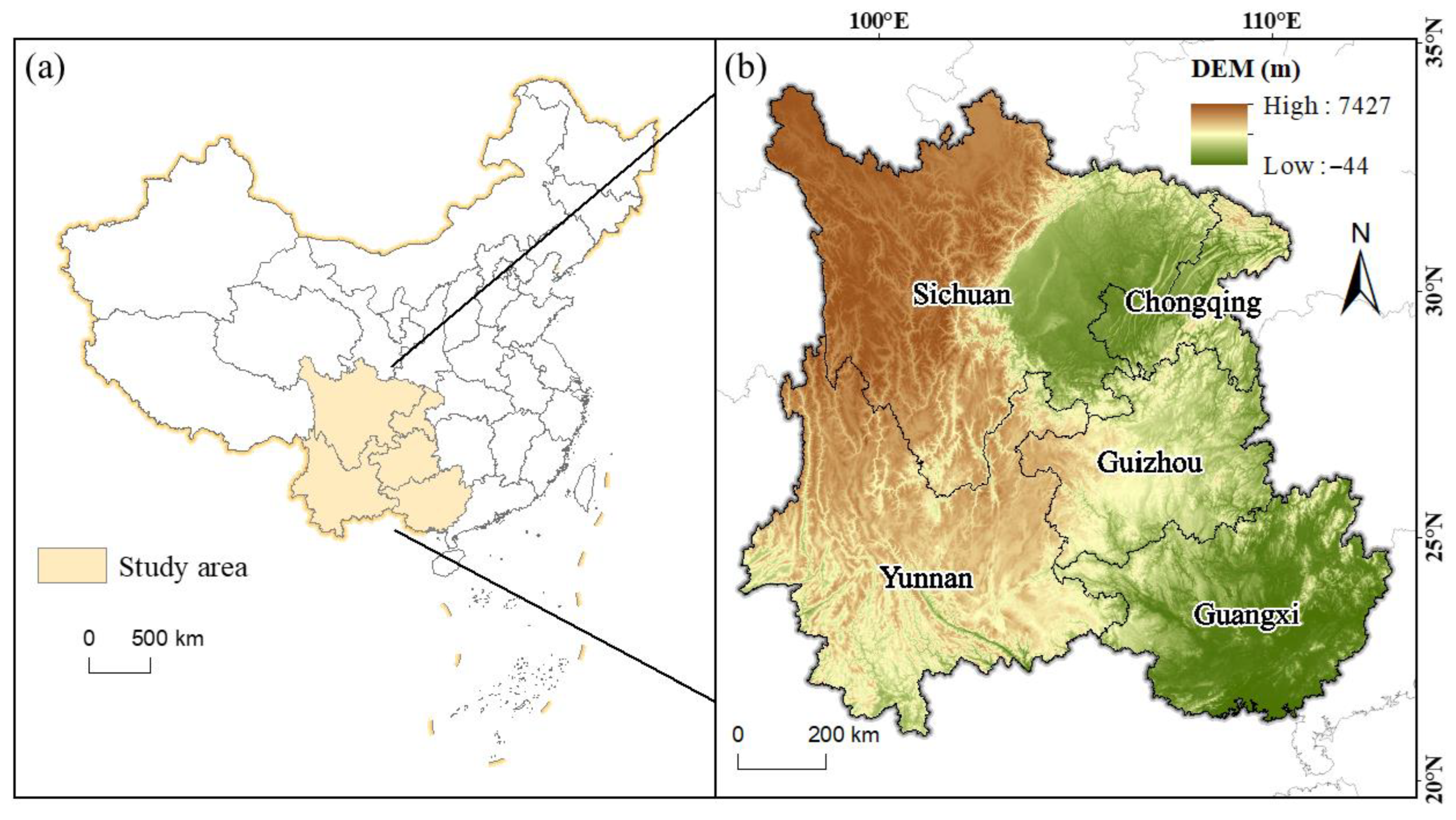
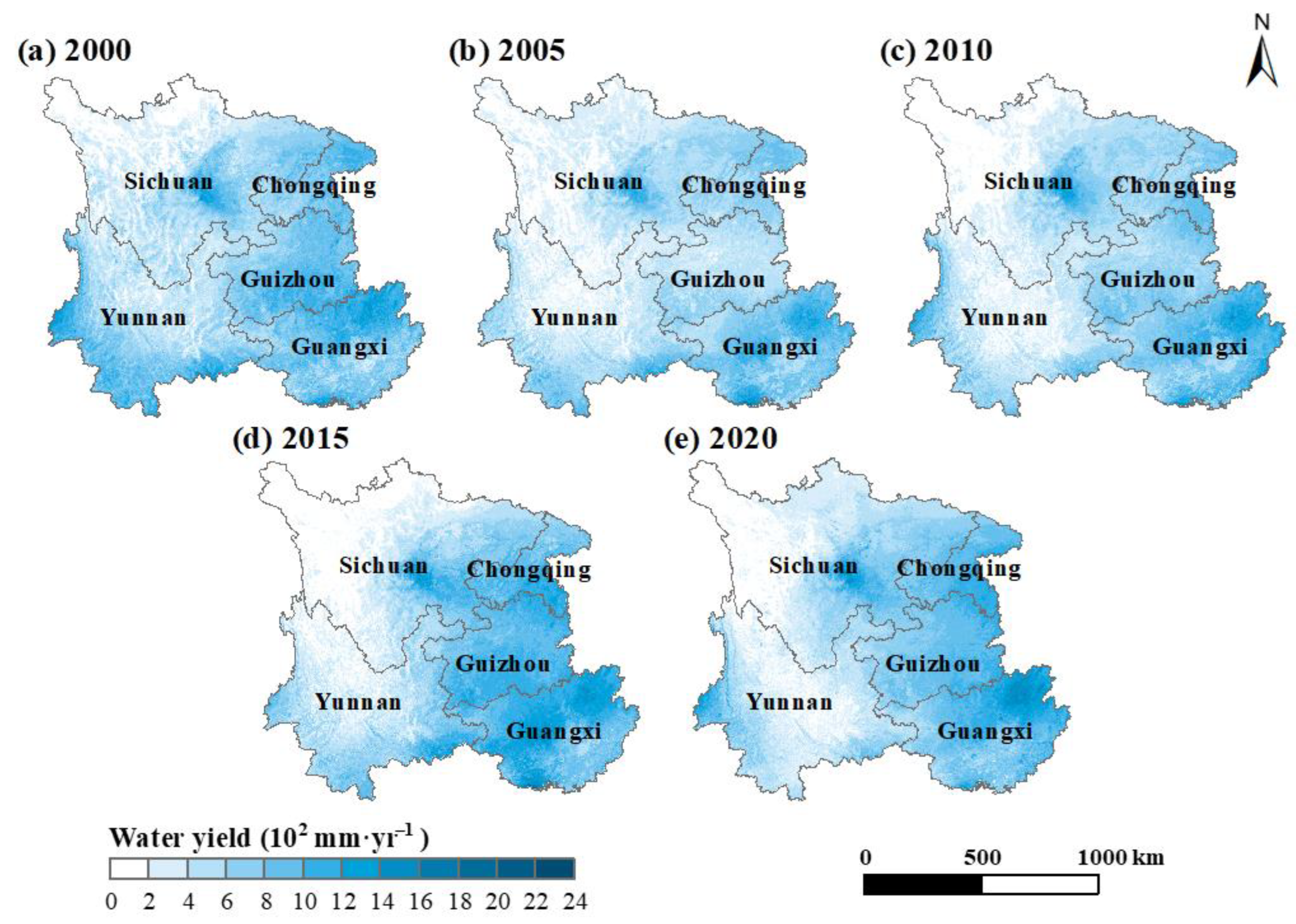
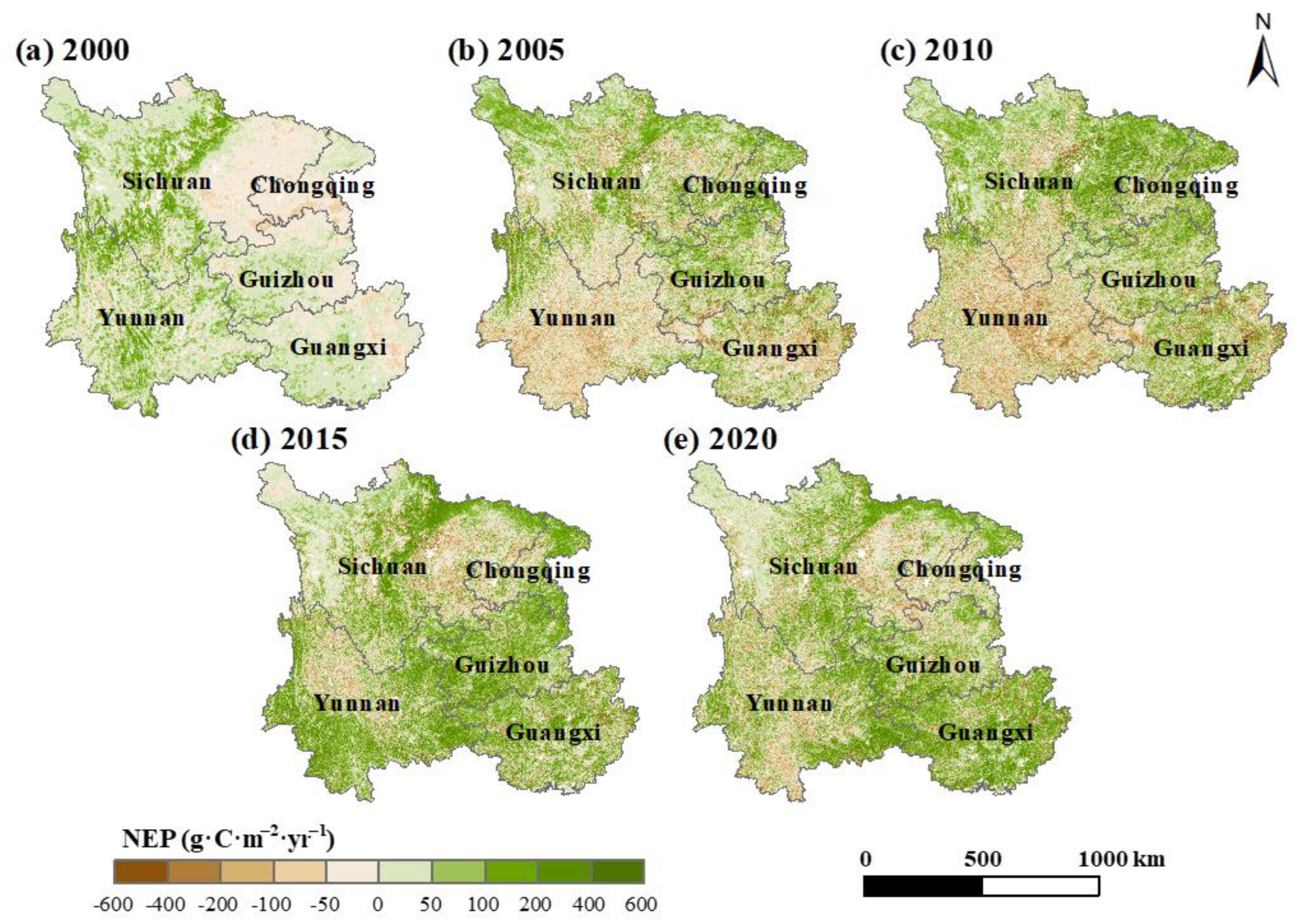
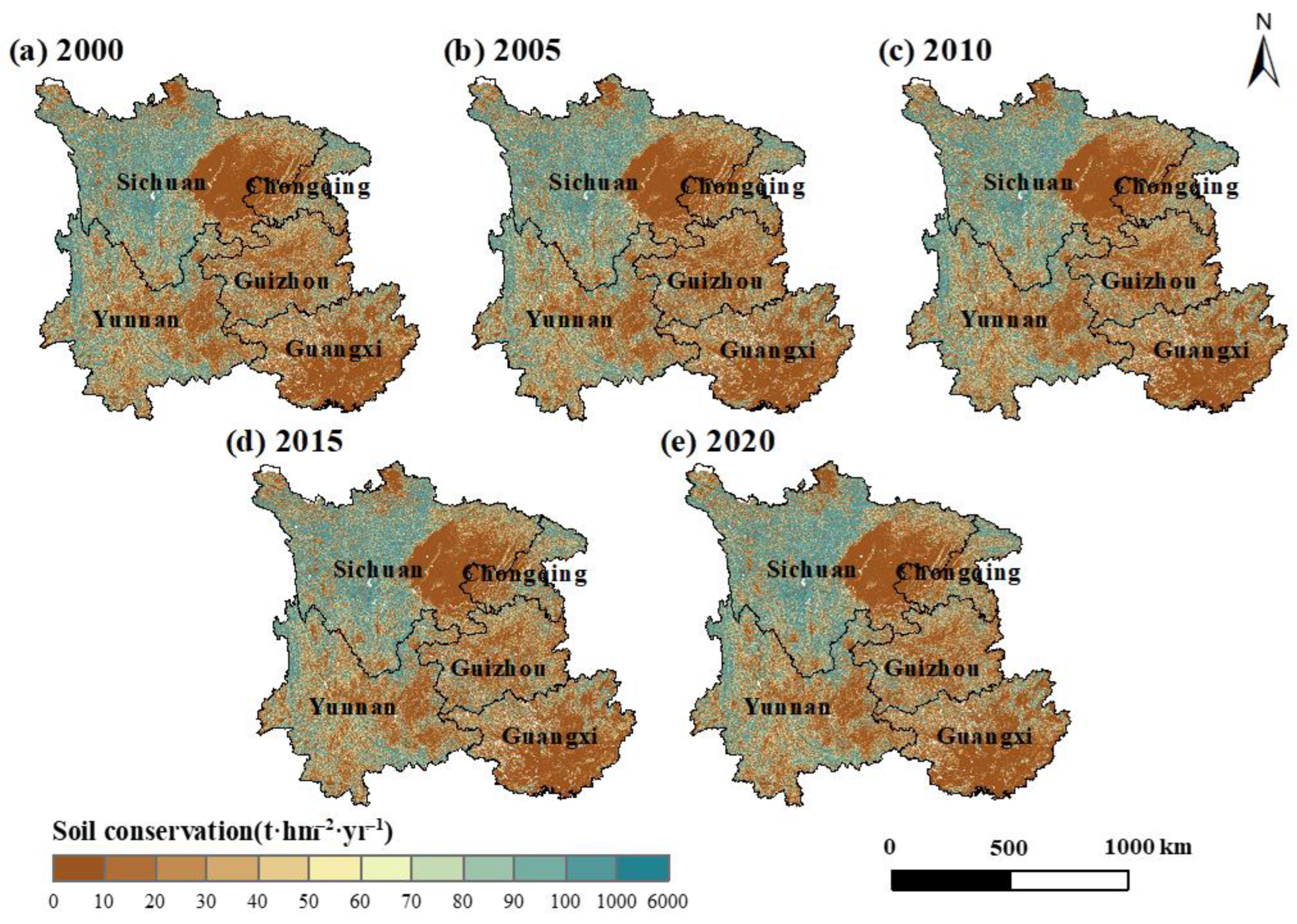
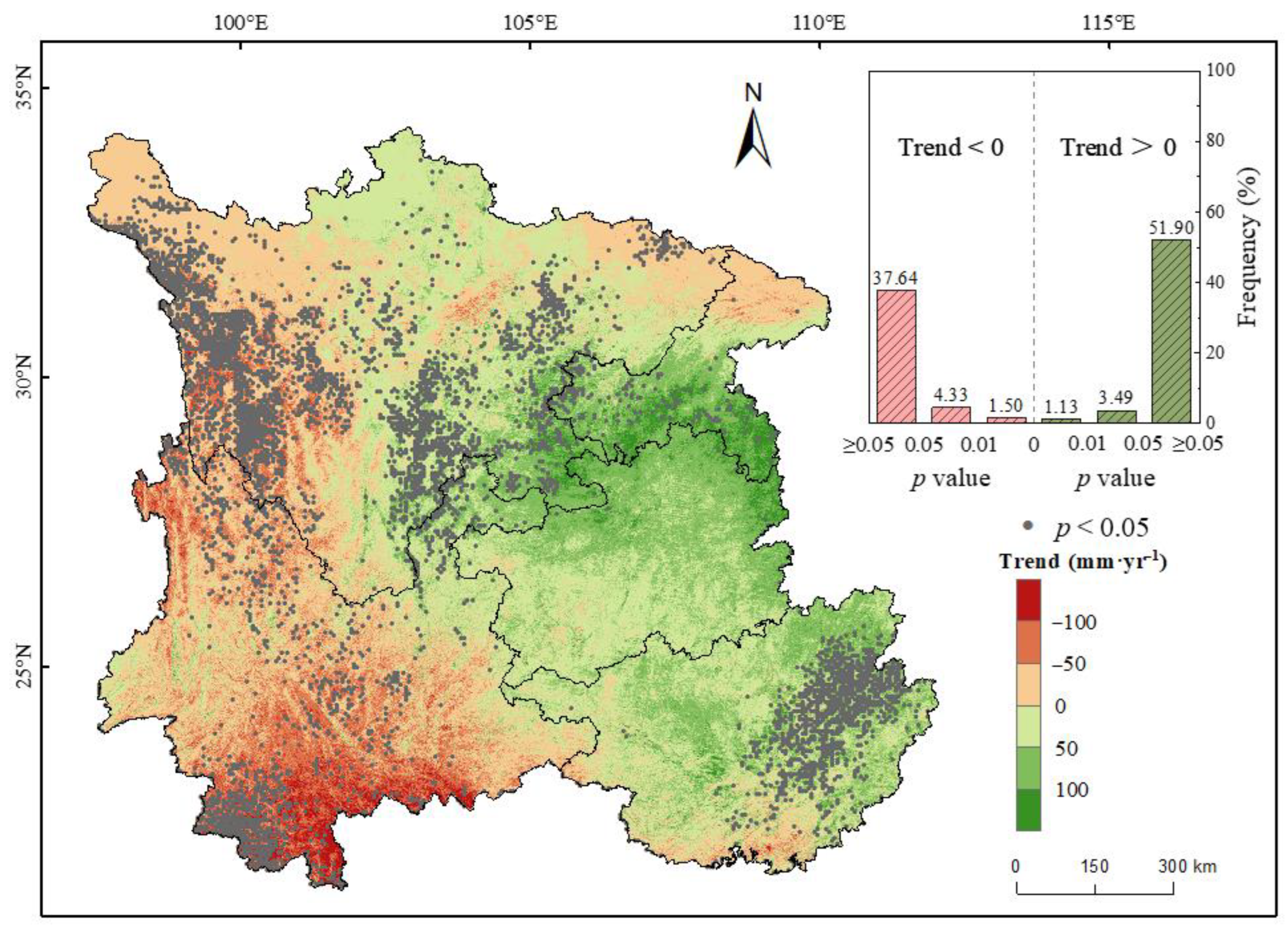
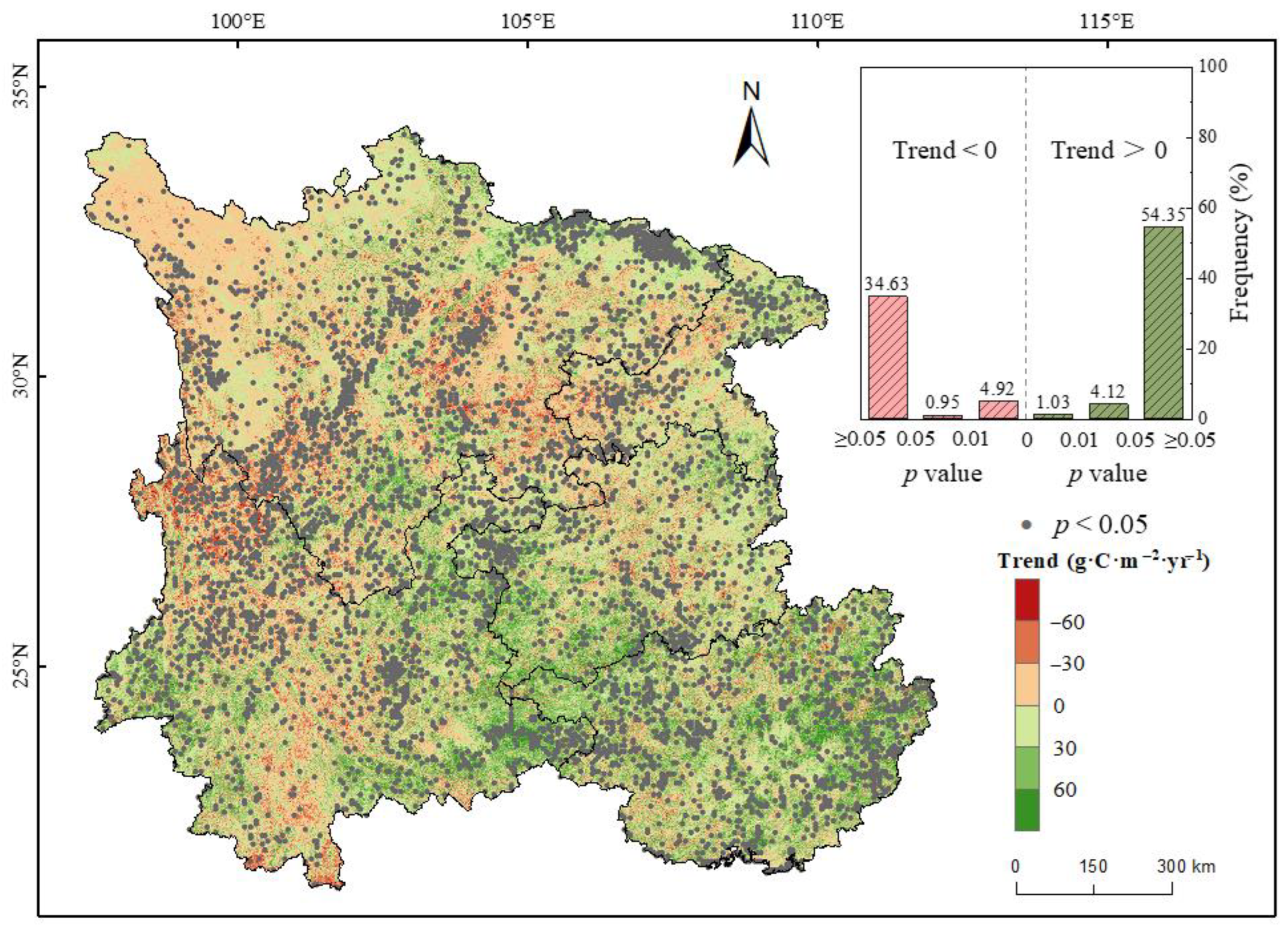

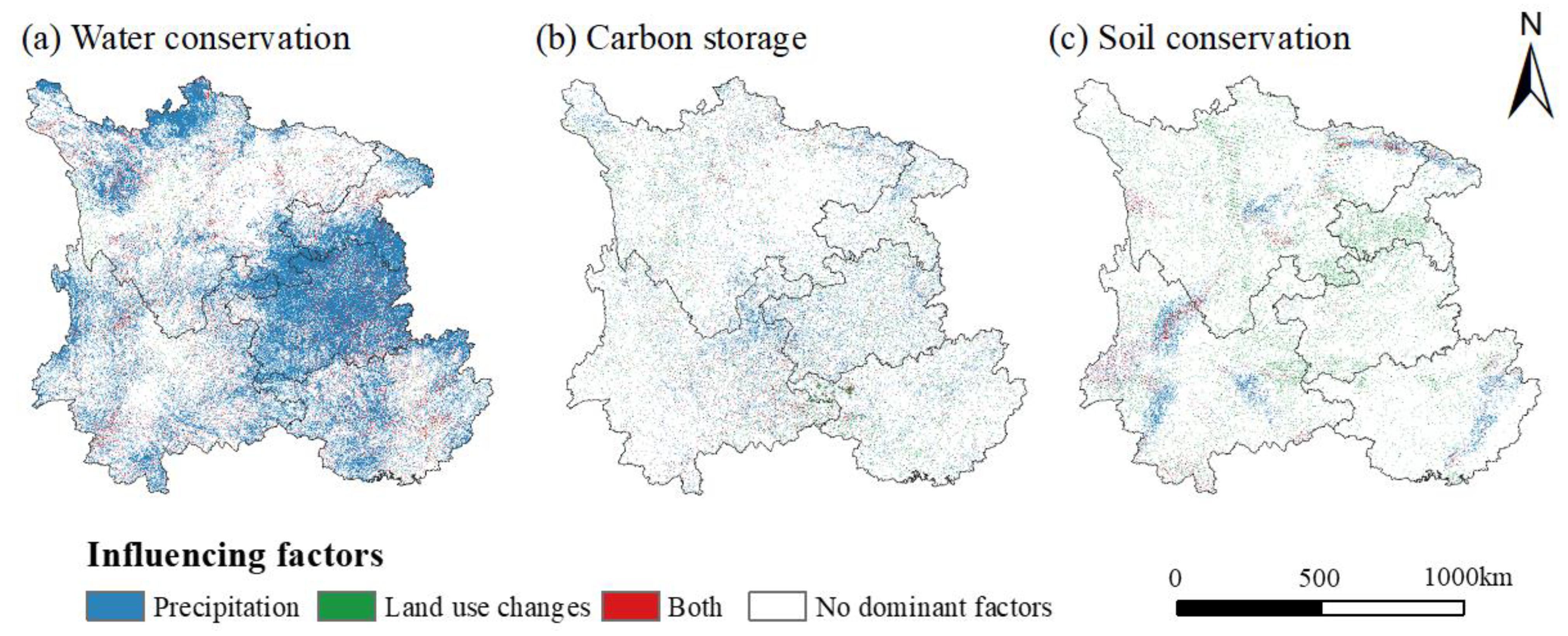
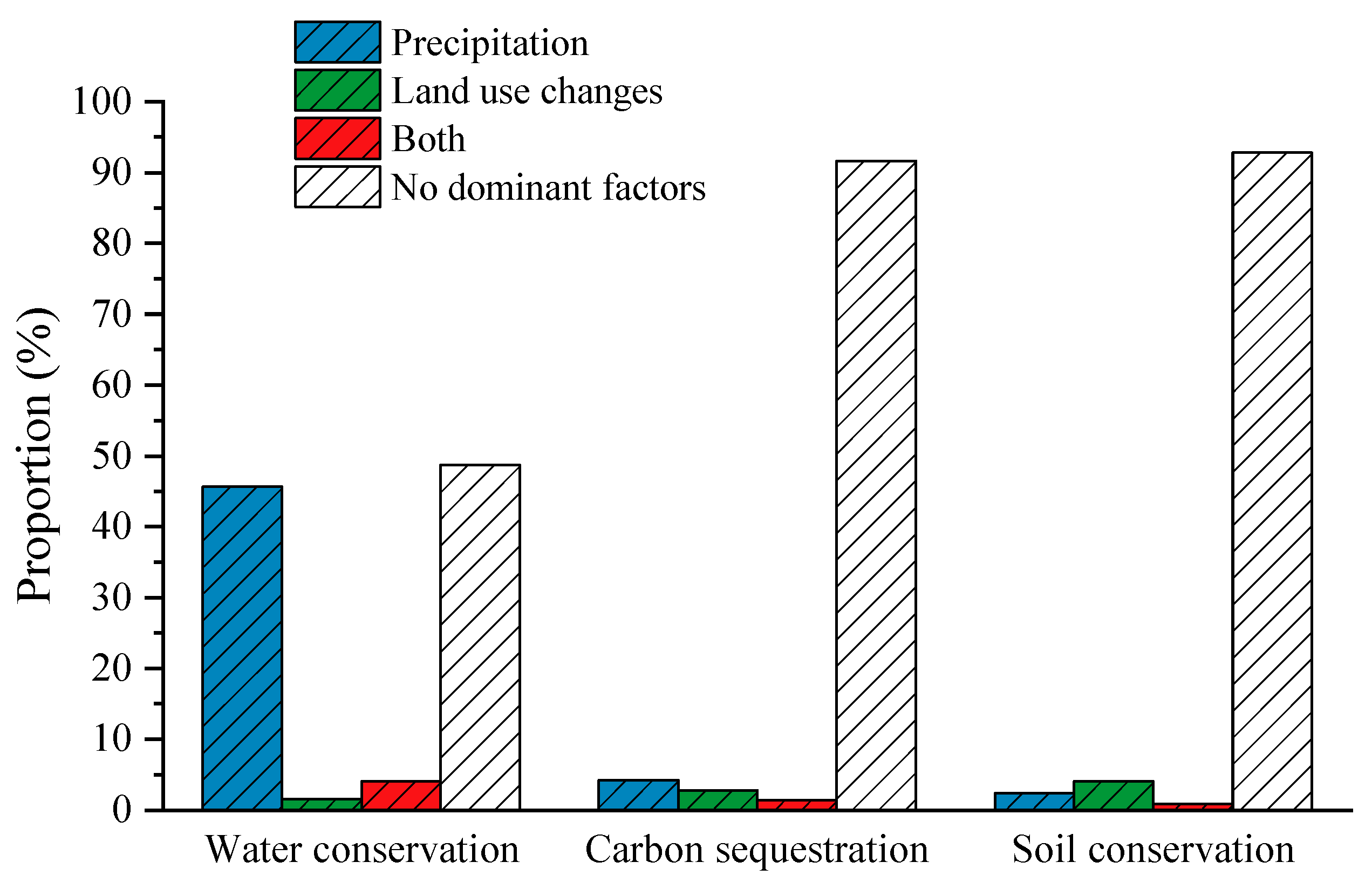

| Land Use | C | P |
|---|---|---|
| Construction land | 0 | 1 |
| Farmland | 0.3 | 0.2 |
| Forestland | 0.05 | 1 |
| Grassland | 0.3 | 1 |
| Unused land | 1 | 1 |
| Waters | 0 | 0 |
| Ecosystem Service Functions | 2000 | 2005 | 2010 | 2015 | 2020 | 2000–2020 Change Rate |
|---|---|---|---|---|---|---|
| water conservation (m3) | 1.11 × 1012 | 8.69 × 1011 | 9.30 × 1011 | 1.12 × 1012 | 1.06 × 1012 | −4.50% |
| carbon sequestration (t) | 3.01 × 107 | 6.31 × 106 | 1.34 × 107 | 7.66 × 107 | 5.85 × 107 | 94.35% |
| soil conservation (t) | 1.31 × 1010 | 1.28 × 1010 | 1.28 × 1010 | 1.29 × 1010 | 1.30 × 1010 | −0.76% |
| Ecosystem Service Functions (Billion Yuan) | 2000 | 2005 | 2010 | 2015 | 2020 | 2000–2020 Change Rate |
|---|---|---|---|---|---|---|
| water conservation | 1350.46 | 1599.58 | 2020.44 | 2784.32 | 3205.01 | 137.33% |
| carbon sequestration | 4.17 | 7.25 | 8.66 | 4.28 | 4.46 | 6.95% |
| soil conservation | 5172.63 | 7974.90 | 10,564.12 | 10,079.58 | 9192.08 | 77.71% |
| total | 6527.26 | 9581.74 | 12,593.22 | 12,868.19 | 12,401.55 | 90.00% |
Disclaimer/Publisher’s Note: The statements, opinions and data contained in all publications are solely those of the individual author(s) and contributor(s) and not of MDPI and/or the editor(s). MDPI and/or the editor(s) disclaim responsibility for any injury to people or property resulting from any ideas, methods, instructions or products referred to in the content. |
© 2023 by the authors. Licensee MDPI, Basel, Switzerland. This article is an open access article distributed under the terms and conditions of the Creative Commons Attribution (CC BY) license (https://creativecommons.org/licenses/by/4.0/).
Share and Cite
Ci, M.; Ye, L.; Liao, C.; Yao, L.; Tu, Z.; Xing, Q.; Tang, X.; Ding, Z. Long-Term Dynamics of Ecosystem Services and Their Influencing Factors in Ecologically Fragile Southwest China. Sustainability 2023, 15, 12331. https://doi.org/10.3390/su151612331
Ci M, Ye L, Liao C, Yao L, Tu Z, Xing Q, Tang X, Ding Z. Long-Term Dynamics of Ecosystem Services and Their Influencing Factors in Ecologically Fragile Southwest China. Sustainability. 2023; 15(16):12331. https://doi.org/10.3390/su151612331
Chicago/Turabian StyleCi, Mengyao, Lu Ye, Changhao Liao, Li Yao, Zhiqin Tu, Qiao Xing, Xuguang Tang, and Zhi Ding. 2023. "Long-Term Dynamics of Ecosystem Services and Their Influencing Factors in Ecologically Fragile Southwest China" Sustainability 15, no. 16: 12331. https://doi.org/10.3390/su151612331





